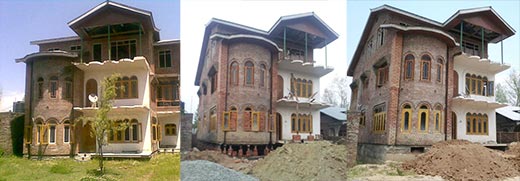What will you do if your house sinks in? Is it possible to lift it up? Inspired by a television series young entrepreneur starts a building lifting firm in Kashmir. Safwat Zargar reports
 The penetration and rapid advancement of science and technology in our daily lives undoubtedly have invoked some hilarious and peculiar reactions from the elderly and traditional people. One such reaction usually used to be and still is; that there will be a time when houses and buildings will be uplifted on jacks, wheeled up on trucks and shifted to different places of our choice. While the moving of a full-fledged building still looks a distant reality to Kashmiris for now, the ridicule of lifting up buildings on jacks isn’t laughable at all.
The penetration and rapid advancement of science and technology in our daily lives undoubtedly have invoked some hilarious and peculiar reactions from the elderly and traditional people. One such reaction usually used to be and still is; that there will be a time when houses and buildings will be uplifted on jacks, wheeled up on trucks and shifted to different places of our choice. While the moving of a full-fledged building still looks a distant reality to Kashmiris for now, the ridicule of lifting up buildings on jacks isn’t laughable at all.
The young boy behind the idea of starting a building uplifting firm in the valley says that he got the inspiration from Discovery channel when he was a kid. “They were really doing something unthinkable,” says Sanan Zaffar Khan, 20, who perhaps is the first entrepreneur of the valley to start an uplifting firm that while using hundreds of jacks and iron channels, lifts up one to-three storied buildings, more than three feet above the plinth.
“The concept is new to Kashmir, but it has been going on since decades in west and India,” Sanan says, who first dwelled in the risky waters of the virgin business in August 2013. A bachelor’s student of civil engineering in Bangladesh, Sanan, once watched a group of engineers and construction professionals, lifting up a 100-year old church, loading it on the huge trawlers and taking it away, on the television. The jaw-dropping Sanan couldn’t believe it, until he saw labourers and engineers, digging beneath the plinth of the building in Ludhiana. This time it was not on television screen, he was watching it with naked eyes.
“It was there I decided of doing something like this in Kashmir,” says Sanan, who schooled in Aligarh. Sanan travelled across India, pooled experts and experienced labourers from Bihar, Jharkand, Bengal, Haryana, Punjab, etc., and put in an initial investment of six lakh rupees. Sanan didn’t advertise his unnamed firm. He still has no name but he has work. Till now, Sanan, though not with any technical experience, with his team of 30 non-local skilled experts and labourers, has; uplifted a three storied house in Bemina by three feet, a 1400 square feet one-storied godown in Batamaloo. He is currently working on a house in Batamaloo that needs to be uplifted by four feet. He is almost done with grabbing a contract from government for lifting up a government guest house in Srinagar.
“We charge 200 rupees per square feet,” he says, “the process of lifting up is fraught with dangers, so there needs to be a lot of caution and care on our part.” The building uplifting is done by digging near the circumference of a structure, iron channels are fixed on the bottom of house and then an alternate plinth to hold the jacks is constructed, as almost 400-500 jacks eventually hold up a house, the material of previous plinth is excavated. The digging simultaneously takes place under the inners walls of the building, so as to ensure the balance while lifting up.
“We can lift every kind of house; whether mud, wooden, concrete,” Sanan says. “There is a huge potential for lifting firms in Kashmir as there is no uniform code of engineering standards followed by people in the valley while constructing houses,” he says. “There is no impact on the overall strength of an uplifted structure.”
Maybe this is the reason that Sanan has received almost 7-8 requests from customers to inspect the site during this year. The requests are particularly from the areas like Bemina, Hyderpora, Rawalpora, Mehjoor Nagar where the level of road and houses are not at par and as a result of which clogged rain water seeps into the residential colonies.
It takes a full month to lift up a structure by using manual jacks, machines, cutters, construction equipments, angle-iron, sand, iron rods and cement. Sanan says that he can start work simultaneously at four locations with his group of 120 people. All of his workers are from outside J&K. He boasts that with the level of expertise of his firm at this time, he can uplift a building or structure spread over 7-8000 square feet by more than 40 inches.
“It’s a technical job and we need people who are already experienced in the field,” Sanan says, while explaining the dearth of Kashmiri experts and engineers in the uplifting business.
“This is not a rocket science,” he says. “You just need to be interested in it. That’s all.”















